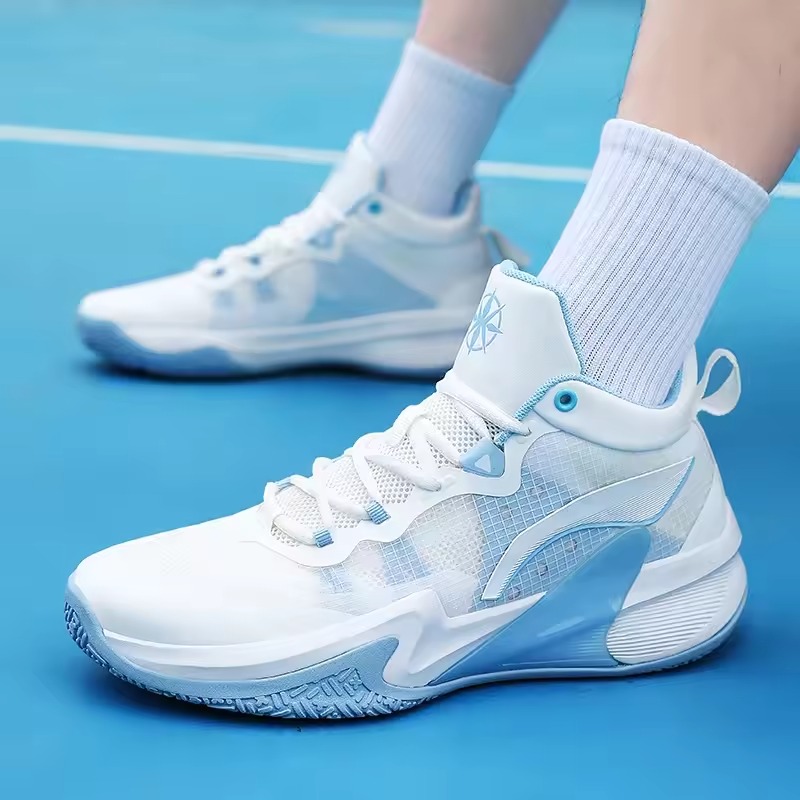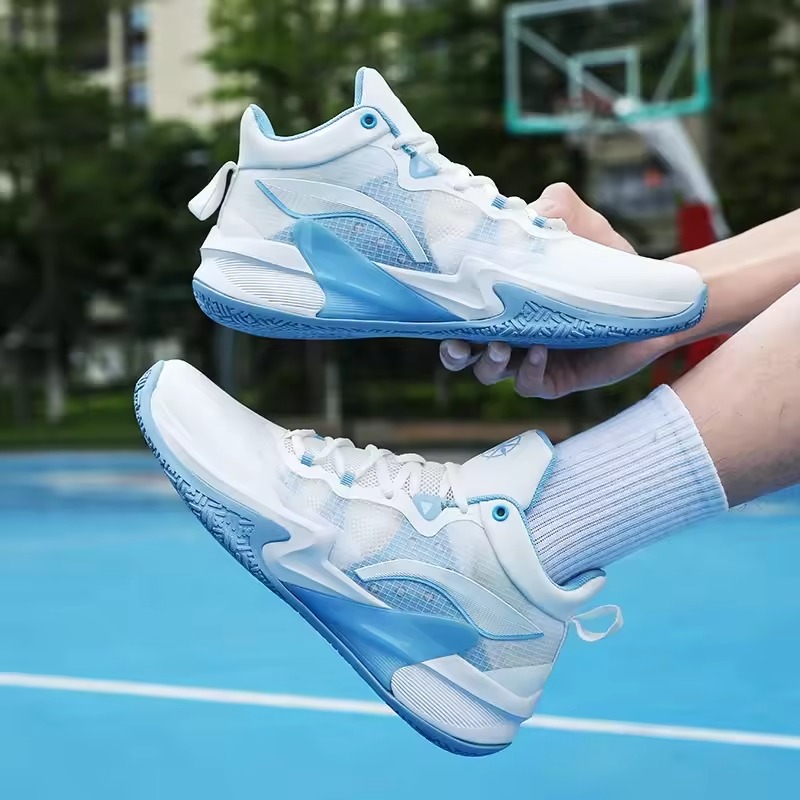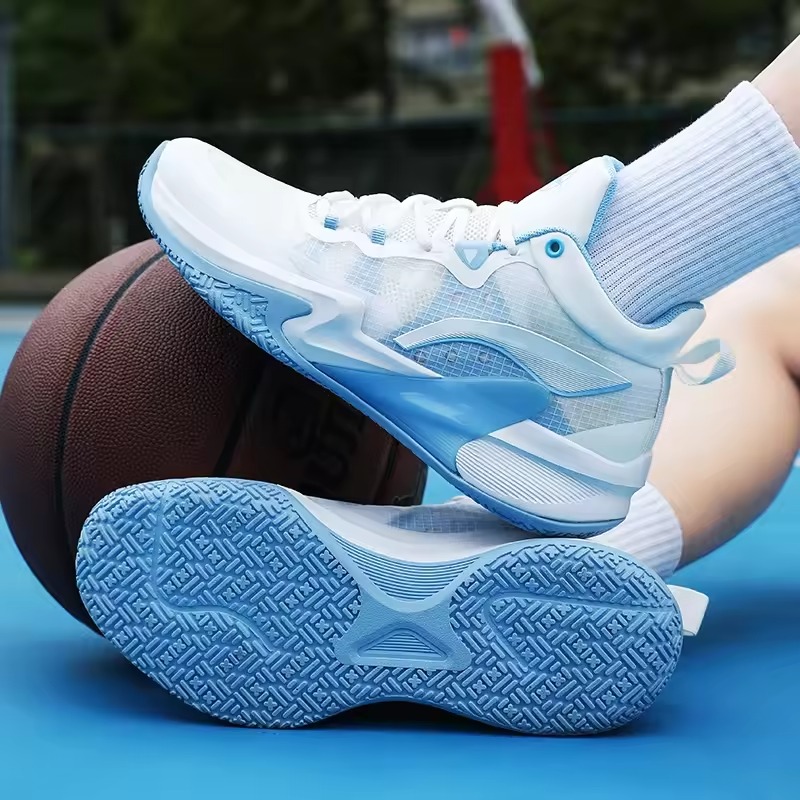The Importance of Proper Shoe Lacing in Basketball
Lacing your basketball shoes the right way is key. It ensures feet are secure during quick moves. Good lacing prevents slips, trips, and injuries on the court. It also gives your foot the precise support it needs.

What happens with wrong lacing? You risk not only discomfort but also ankle sprains. A wrongly laced shoe can impact your game. Think about a shoe coming loose during a critical play. Proper lacing allows players to pivot, jump, and run with confidence.
The right lacing technique distributes pressure evenly across your foot. This is vital for balance and control. It also helps to avoid blisters and hotspots, which can hinder your performance. Remember, a shoe that fits well but is laced poorly won’t give you benefits.
In summary, good lacing affects safety, comfort, and performance in basketball. It’s a skill as crucial as dribbling or shooting. Learn the best ways to tie basketball shoes for your game. You’ll see how it changes your experience on the court.
Different Lacing Techniques for Basketball Shoes
Finding the right lacing method can boost your game. Let’s dive into some popular techniques.
Criss-Cross Lacing
This classic style is simple and effective for most players. Start at the bottom and cross laces over each other as you move up.
Loop-Lacing Lock
Also known as ‘heel lock’ or ‘runner’s loop’. It gives extra ankle support. Make a loop on each side before the last eyelet and cross the ends through these loops.
Straight Bar Lacing
This method reduces pressure on the top of the foot. Run the laces straight across from eyelet to eyelet in parallel lines.
Ladder Lacing
Widely used among military personnel, ladder lacing offers tight support. Laces weave vertically and horizontally, creating a ‘ladder’ look.
Zig-Zag Lacing
A fun and functional approach with laces crossing in zig-zag patterns. It can be adjusted for tighter or looser fit.
High-Top Specific Lacing
High-tops require special attention. They need lacing that secures the ankle firmly. Extend laces to the upper eyelets for increased stability.
Using the right lacing technique matters. It can change how you play basketball. Tying your shoes to fit snugly can prevent injury and improve your performance. Include these methods when you learn how to tie basketball shoes. You’ll feel the difference in support and comfort on the court.
Step-by-Step Guide to Lacing Your Basketball Shoes
Lacing your basketball shoes correctly is essential. Follow this guide and enhance your gameplay. Here is a step-by-step method applying popular lacing techniques.
Preparing Your Shoes and Laces
Before you start, make sure your shoes are clean and the laces are untangled. This makes the process smoother.
Starting at the Bottom
Begin by threading each lace end through the bottom eyelets. Make sure the laces are even.
Criss-Cross Lacing
Cross the laces over in an ‘X’ pattern. Continue upwards, ensuring each cross is snug.
Loop-Lacing Lock
After reaching the second to last eyelets, make loops. Cross the laces through the loops for a heel lock.
Straight Bar Lacing
For less pressure on your foot, lace straight across instead of criss-cross. Thread horizontally from eyelet to eyelet.
Ladder Lacing
Weave the laces vertically and horizontally. This provides a secure and tight fit, resembling a ladder.
Zig-Zag Lacing
Start with standard criss-cross. Then, zig-zag the laces for a blend of tightness and comfort.

High-Top Specific Lacing
For high-tops, extend the laces to the upper eyelets. This ensures better ankle stability.
Finishing with a Secure Knot
Once you reach the top, tie a secure bow knot. Double knot if needed for extra security.
Remember, your lacing technique can change how to tie basketball shoes for the best fit. With practice, these steps will become second nature. You will notice improved comfort and support, allowing you to focus on the game.
Adjusting Laces for Optimal Comfort and Support
Getting the perfect fit with your basketball shoes is essential. Here’s how to adjust laces for comfort and support.
Check the Fit Regularly
Your feet can swell during play. Pause to check the fit and retighten laces if needed. This prevents discomfort and supports feet well.
Make Micro-Adjustments
Different parts of the foot need different tension. Adjust laces, so they’re not too tight or too loose. Doing this adds comfort and avoids pressure points.
Lacing for Your Foot Shape
Everyone’s feet are unique. Lace your shoes in a way that suits the shape of your feet. This ensures comfort and better in-shoe feel.
Lacing Up for Different Playing Styles
Your style on the court might need specific lacing. Make the fit snug for quick moves, or slightly looser for endurance.
Testing and Learning
After adjusting, walk around. Feel how the shoe moves with your foot. It should feel secure without pinching. Keep adjusting until it’s right.
Remember the Basics
Always start from the bottom and work your way up. Keep laces flat to avoid twisting. Twisted laces can lead to discomfort.
Adjusting your basketball shoe laces isn’t just about a perfect fit. It’s about maintaining support and comfort longer on the court. Take time to learn how to tie basketball shoes that help you play your best.
Common Mistakes to Avoid When Lacing Basketball Shoes
Lacing your basketball shoes seems straightforward, yet some errors can harm your game. To ensure top performance and comfort, you must sidestep these common lacing mistakes.
Ignoring the Importance of Evenly Distributed Tension
Uneven tension in your laces can create pressure points. It can lead to discomfort and affect your footwork. Lace your shoes evenly for a flawless fit.
Lacing Too Tight or Too Loose
Tight laces may cause circulation issues and numbness. Conversely, loose laces might fail to provide sufficient support. Find a balance that secures your feet and allows for natural movement.
Skipping Eyelets
Some skip eyelets to save time or for comfort. This method can decrease the shoe’s stability and support. Use all eyelets to optimize the shoe’s design for your foot’s security.
Not Adjusting Laces as You Play
Feet might swell during games or practices. Not adjusting your laces accordingly can result in a poor fit. Take quick breaks to retighten if needed for continuous comfort and support.
Using Worn-Out Laces
Old, stretched laces won’t hold your foot firmly. Ensure you replace laces when they show signs of wear. This prevents unexpected loosening or breaks.
Forgetting to Double Knot
A single knot may come undone when you’re making dynamic moves. Secure your laces with a double knot to avoid tripping hazards during play.
By evading these lacing pitfalls using the keyword on how to tie basketball shoes, you can elevate your play. Correct lacing supports precise footwork and can save you from unnecessary pauses or injuries on the court.

The Relationship Between Lacing Techniques and Performance
Choosing the right way to tie your basketball shoes can greatly influence your game performance. With proper lacing techniques, each player achieves a custom fit that caters to their individual playing style and foot shape, which directly impacts how they play.
Foot Stability and Movement Precision
A secure lacing system provides the necessary stability for the foot. It allows for precise, quick movements without the fear of the shoe slipping off. A stable shoe lacing system can lead to better control, especially when stopping abruptly or changing directions, which is common in basketball.
Injury Prevention
Correct lacing can help avert common foot injuries. When laces are evenly tensioned, they offer consistent support around the foot. This can prevent excessive movements that might cause sprains or twists. Learning how to tie basketball shoes with the proper tension is key to safety.
Comfort Leads to Better Endurance
Comfortable laces means less distraction and more focus on the game. When your feet feel good, you can play longer and harder. A lacing technique that spreads pressure evenly reduces the chance of blisters and sore spots.
Enhanced Shoe Performance
The performance of basketball shoes is affected by lacing. Well-laced shoes take full advantage of their design features, like cushioning and arch support. Correct lacing unlocks the shoe’s potential for peak performance.
Adaptability to Changes During Play
As your feet change during play, so can your laces. The right lacing allows for easy adjustments. Quick tweaks can ensure continuous comfort and support,
By understanding the connection between lacing techniques and performance, players can tailor their lacing for the best game. Remember, knowing how to tie basketball shoes is an advantage on the court. It’s a simple skill that has a complex effect on how you play.
Tips for Maintaining Your Basketball Shoes and Laces
Maintaining your shoes and laces is crucial for peak performance. Regular care ensures longevity and effectiveness on the court. Here are practical tips to keep your basketball gear in top shape.
Inspect Shoes and Laces for Wear and Tear
Check your shoes and laces often for signs of damage. Look for frayed laces or worn outsoles. Early detection prevents bigger issues later.
Clean Your Shoes Properly
Wipe off dirt and sweat after each game. Use a soft brush and mild soap for deeper cleans. Dry your shoes in open air but away from direct sunlight to avoid damage.
Replace Laces as Needed
Don’t wait for laces to break. Replace them if they show signs of stretching or fraying. New laces ensure secure and snug lacing.
Store Shoes in a Dry Place
Moisture can harm your shoes. Store them in a dry, cool place after use. This prevents mold and keeps the shape intact.
Keep an Extra Pair of Laces Handy
Always have spare laces in your bag. Quick replacements can save you during unexpected lace failures.
Be Mindful of Lacing Techniques
Use lacing techniques that suit your play. Re-lace your shoes regularly to stay comfortable and supported.
Avoid Excessive Heat
High temperatures can warp your shoes. Do not use a dryer or leave them in a hot car.
Caring for your basketball shoes and laces is an ongoing process. Adopt these habits to ensure your gear supports every jump, pivot, and sprint. Remember, how to tie basketball shoes starts with well-maintained equipment.
Best Practices for Quick Lacing During Timeouts and Breaks
During timeouts and breaks, quick lacing is key. It helps players return to the game fast. Here’s how to tie basketball shoes quickly and efficiently.
Use Easy-to-Grip Laces
Choose laces that are easy to hold and pull. This saves time and hassle when adjusting.
Practice the Two-Second Tug
Master a method where a firm tug aligns the laces. This ensures even tension quickly.
Prepare the Laces Before the Game
Arrange laces loosely before the game. They should be ready for rapid tightening later.
Learn One-Handed Adjustments
Develop the skill to tighten laces with one hand. This frees up the other hand for balance.
Have a System
Create a personal lacing system. It should allow you to secure your shoes swiftly.
Stay Calm
Don’t rush and make mistakes. Keep cool, and lace efficiently. Panic slows you down.
Double-Check the Knot
Ensure the knot is secure. A quick check prevents stops in game play later on.
Consider Slip-Ons or Locks
For ultimate speed, consider slip-on shoes or lace locks. They offer fast and reliable closure.
Following these steps, players can keep shoes snug and secure. Quick lacing during breaks avoids delay. It keeps the focus on the game. Proper technique and a bit of practice make it easy. Remember, knowing how to tie basketball shoes swiftly benefits any player.